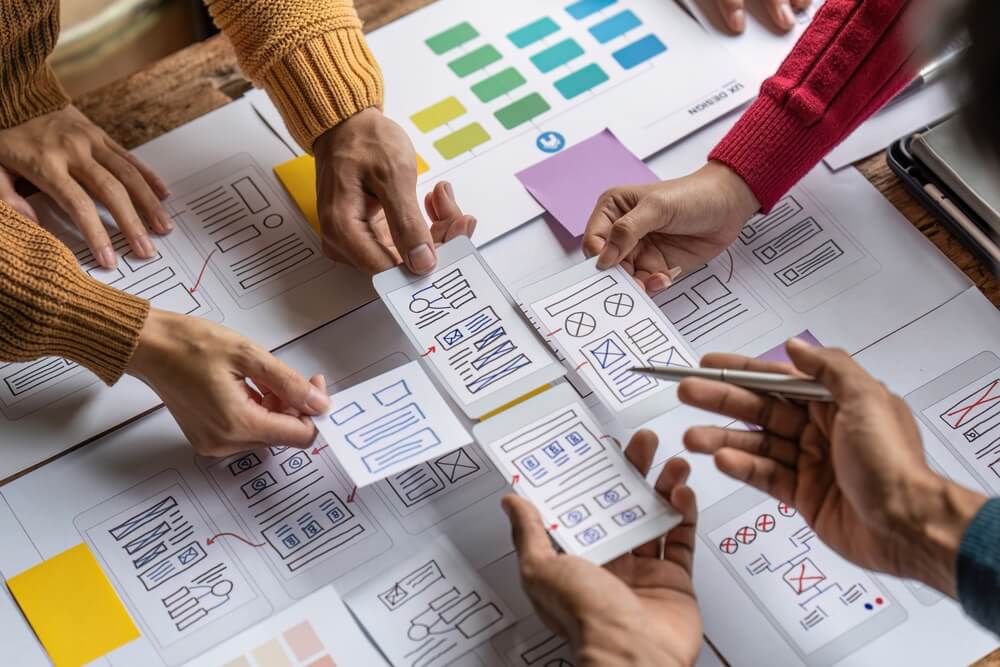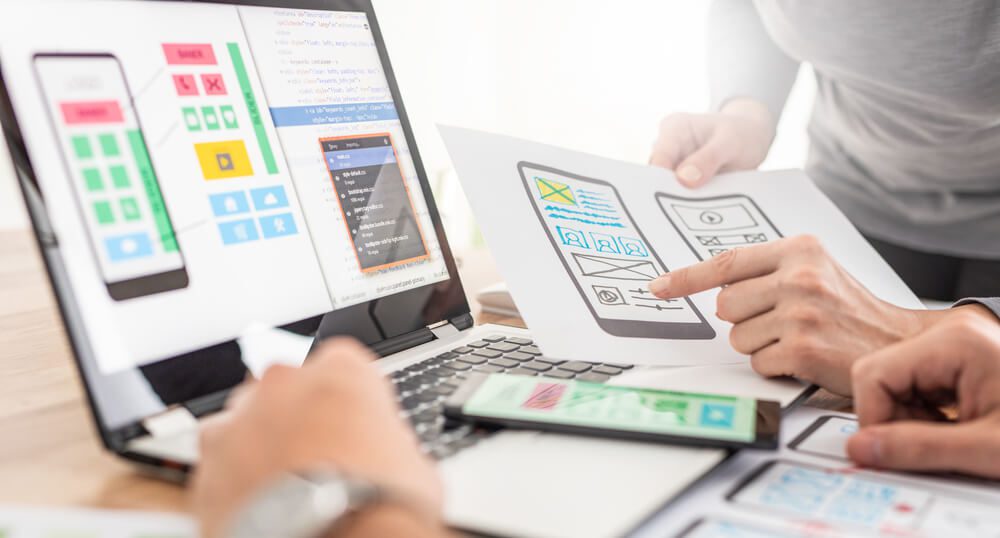
Guide to Steps and Stages of Every Great UX Design Process
Behind every great product is a carefully planned and executed user experience (UX) design process. It is the flow that even the best UX agency follows, although it customizes the elements according to your needs.
This article discusses all seven steps:
- Define the project.
- Research user and customer needs.
- Plan the interface’s flow and structure.
- Design the interface.
- Create the prototype.
- Test the product.
- Launch and refine the product.
Ready to know what goes into creating a responsive, usable app or website? Read the article below. Let's go!
To learn how Digital Authority Partners can create a standout website for you, watch this video!
1. Define the Project
Everything begins with a goal.
- Why are you making the app or site in the first place?
- Is the platform meant to complement your other channels?
- Do you want brand awareness or bigger revenue?
- Are you doing demand generation or lead generation?
During the Define Stage, you and the UX agency establish a crystal-clear understanding of the scope, objectives, target audience, and specific problem that the product aims to solve. You meticulously outline the project’s purpose.
One of the essential steps to take at this point is to determine your team members. As shown by this Cove Market case study, collaboration matters among departments. Depending on the complexity, you likely need a researcher, designer, developer, writer, marketing strategist, and project manager.
2. Research User and Customer Needs

Users are at the heart of any UX design. The AIVA case study by Digital Authority Partners (DAP) shows the great advantages of putting their benefits first.
However, what happens if your users and customers (those who pay for the product) differ? This situation is common in B2B markets, where executives and decision makers hold the purse strings but do not daily interact with the platform.
A UX agency helps bridge this gap and creates a product that satisfies both. It acts as a mediator, ensuring that the project and design process remain user-centered while addressing business goals.
During the Research Stage, the team dives deeply into user behaviors, motivations, pain points, and expectations. You create empathy maps and user journey maps from the wealth of gathered data for a holistic view of the entire user experience. This visual representation helps identify the most salient features and functionalities.
With all of these types of research, the agency can now effectively communicate to business leaders the value of user-centric design, especially on the bottom line.
3. Plan the Interface’s Flow and Structure
In many ways, the Planning Stage is a design challenge. At this phase, the team takes all of the information gathered in the Research Stage and starts to outline how to meet those requirements. In particular, they should:
- Understand the job demand.
- Identify the best activities to produce the desired outcome, given the available resources.
- Feel confident in their tools and techniques because even minor errors can be catastrophic.
Designers delve into the specifics, refining the vision into tangible elements when planning. They will do the following:
- Determine the color scheme, taking into consideration factors such as brand identity and psychological impact on users.
- Create a consistent and visually appealing interface.
- Develop user descriptions and personas to tailor the product's design to meet their preferences, expectations, and usage patterns.
- Identify a detailed project timeline, outlining the milestones and deadlines.
4. Design the Interface

In this fourth stage – the Design Stage – the UX agency creates the actual user interface. This involves choosing colors, fonts, layouts, and other elements to create a user-friendly experience. This stage falls into two categories: low- and high-fidelity design.
Often referred to as wireframes or sketches, low-fidelity designs are rough, simplified representations of a digital product’s interface. They focus on the layout and structure without the intricate details or visual elements.
They are also:
- Quick and easy to produce, making them ideal for rapid prototyping and iterating on design concepts.
- Excellent for establishing user flow and information hierarchy.
- Highly flexible, which means changes and revisions can be quick.
Meanwhile, high-fidelity designs involve detailed mockups or interactive prototypes. They are refined representations of the final product’s visual and interactive elements. They closely resemble the user interface, incorporating color, typography, imagery, and animations. Further, they:
- Offer a realistic preview of the product, providing stakeholders and clients with a tangible representation of the final look and feel.
- Ensure design consistency across all screens and elements.
- Serve as essential references for developers during the implementation phase.
- Are ideal for presenting the platform to clients or stakeholders.
Choosing between them depends on the project’s stage and goals. Low-fidelity designs are more suitable for exploring ideas and quickly validating concepts. As the project progresses and design decisions solidify, high-fidelity designs are essential for refining the visual and interactive elements.
5. Create the Prototype
A prototype is an interactive simulation that allows users and stakeholders to experience the product’s flow, interactions, and functionalities before the final development phase.
It is pivotal because it brings the product to life, allowing users to interact with the interface as they would with the actual one.
Users can also test the prototype for valuable feedback, while designers may refine and validate their decisions during the earlier stages. Validating the design through a prototype reduces the risk of costly changes during development.
A UX agency uses various prototyping tools available, depending on their skills and project requirements. Some popular features include real-time collaboration, seamless design-to-prototype workflows, and app integration.
6. Test the Product

The benefits of testing before, during, and after launch are huge and cannot be overstated. It ensures that the platform or website satisfies the needs of its users and meets industry standards and regulations.
The UX agency best determines the types of tests ideal for the project. Two of the most essential are usability and accessibility to prevent your website design from tanking.
Usability evaluates the ease of use and efficiency of the product. It involves observing real users interacting with the prototype or the platform and collecting feedback on their experience. This way, the team can:
- Uncover any challenges that users might encounter while navigating through the product.
- Gather evidence-based insights to support or refine design choices.
- Gauge how quickly people can complete tasks.
On the other hand, accessibility testing shows that your site or app is useful for individuals with disabilities. In particular, this process evaluates the product’s compliance with standards, including the Americans with Disabilities Act (ADA), especially with the following:
- Screen-reader compatibility.
- Keyboard navigation.
- Color contrast.
- Captioning and transcripts.
7. Launch and Refine the Product
This stage marks the official release of the digital product to the target audience, but it does not end there. Instead, it begins an ongoing process of monitoring, gathering feedback, and continuously improving to ensure its long-term success. The team does the following:
- Thoroughly tests that it functions as intended and meets the design specifications.
- Addresses any remaining bugs or issues before the launch.
- Develops a comprehensive communication and marketing strategy such as social media campaigns, email marketing, and press releases.
- Implements analytics tools to track user behavior and gather data.
- Encourages users to provide feedback through various channels such as in-app feedback forms, surveys, or customer support.
- Regularly audits the product for security and standard compliance.
- Looks at market trends and technological advancements when planning updates and new features.
Summing Up
UX design is a comprehensive and iterative journey that places users at the heart of product development. Designers can create apps and sites that deliver exceptional experiences and drive business success by prioritizing user needs, preferences, and expectations throughout each stage.
Need help? As a leading UX agency, Digital Authority Partners (DAP) collaborates closely with clients to understand their business goals and align them with user expectations. Contact us to learn more.
Want To Meet Our Expert Team?
Book a meeting directly here




